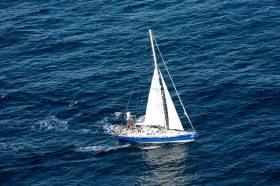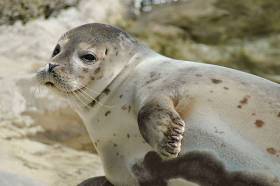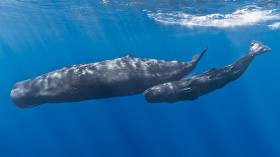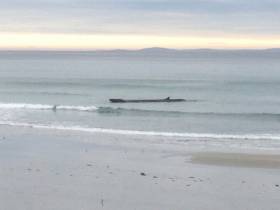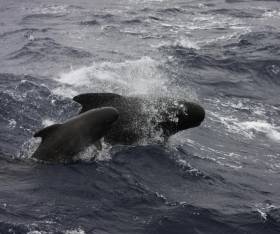Displaying items by tag: Whales
Large Carcass Spotted In Celtic Sea Area Popular With Fin Whales
#MarineWildlife - Naval Service personnel on patrol with the LÉ Samuel Beckett encountered the carcass of a large whale some 50 nautical miles south-east of Ballycotton Lighthouse in the days after Christmas.
The “mystery whale” is neither a sighting (which only counts or living cetaceans) nor a stranding. But as the Irish Whale and Dolphin Group (IWDG) says, the encounter “serves to remind us that the animals that wash up on our shoreline may represent only a small percentage of the total number of cetaceans that expire at sea of presumably natural causes.”
IWDG sightings officer Pádraig Whooley said the location of these whale remains was “interesting as this area of the Celtic Sea has produced the most consistent large-whale sightings in recent months, with fairly regular sightings of fin whales from land-based sites between Ram Head, Ardmore extending east towards the Hook Head lighthouse.”
Arctic Beluga Among Whale Species Recorded In Irish Waters In New Research
The Beluga whale — a species mainly found in the Arctic Circle — has been recorded in Irish territorial waters as part of a groundbreaking three-year research project into our offshore habitats for marine wildlife.
On Friday (23 November) the ObSERVE Programme team announced the findings of its aerial and acoustic projects, led respectively by UCC and GMIT and which survived larked areas of the Irish and Celtic seas as well as the Atlantic Margin.
Besides the begula, the researchers detected endangered blue whales underwater up to 200km from their survey position, noting strong seasonal patterns in their sounds.
The most abundant baleen whale species is the minke whale, whose numbers in Irish waters reach some 12,000 in summer months and 5,000 in winter, including significant sightings of calves.
Fin whales were also recorded throughout the year, suggesting the continental slope and adjacent deep waters are an important area for this species.
Numbers of deep-water beaked whales — recently the subject of concern over mass strandings in Ireland and Scotland — were also estimated to reach some 4,000 in winter months.
In addition the ObSERVE Programme studied distribution and behaviour of dolphin species, as well as the half a million seabirds of the Atlantic Margin — which included sightings of white-tailed tropicbirds normally found much further south.
The news comes just days after a rare spotting of killer whales in pair off the coast of Co Dublin — and as hundreds of translucent parasitoid phronima have washed up on a beach near Dingle, as TheJournal.ie reports.
Seals Released Off North Coast After Extended Exploris Stay
#MarineWildlife - Two common seals were released off the North Coast last week after being nursed back to health at the Exploris aquarium in Portaferry.
According to The Irish News, the seals named Hans and Albert had been with the sanctuary since the summer, when they arrived with various injuries.
However, by September both had put on weight and were eating by themselves, prompting Exploris staff to plan for their eventual release at Ballintoy Harbour last Wednesday (29 November).
In a techy twist, Hans and Albert have been microchipped so their progress can be monitored from shore over the next few weeks and months.
Also in the care of Exploris staff is a baby seal rescued from a rocky outcrop off Bangor in Belfast Lough in late October.
BBC News has video of the tiny white seal pup, which was suspected to have an injured hip and damaged flipper likely suffered during Storm Ophelia.
Another presumed victim of the stormy weather was a seal recovered from Dun Laoghaire’s East Pier on Hallowe’en.
The Irish Times reports that the marine mammal had sustained injuries to its face and rear flipper, but was said to be doing well in the care of volunteers from the Courtown Seal Rescue Centre in Co Wexford.
More recently, a number of stranded dolphins were successfully returned to the water off Achill Island by locals and volunteers on Tuesday 21 November.
Four common dolphins were reflected from Keem Beach, though a fifth was found dead on nearby rocks. The Irish Whale and Dolphin Group (IWDG) removed the carcass to determine its cause of death, as the Mayo News reports.
Back on the North Coast, BelfastLive says a six-metre whale carcass surprised locals at Runkerry Strand near Portballintrae on 24 November.
The find came just weeks after a much larger fin whale carcass was found on Arranmore off the Donegal coast, as previously reported on Afloat.ie.
Sperm Whale Carcass Washes Up On Wexford Beach
#MarineWildlife - The carcass of an 11-tonne sperm whale has washed up at Carnsore Point in Co Wexford, as the Gorey Guardian reports.
The 8.5m whale — discovered by local man Davie Rea on the rocky shore at the end of last week — was identified as an adult female by the Irish Whale and Dolphin Group (IWDG).
Kevin MacCormick of the IWDG added that the giant marine mammal appeared to be emaciated “so most likely it was not in good health”.
It’s been five years since the last sperm whale stranding on the Wexford coast, as the species is more often found in western waters.
The Gorey Guardian has more on the story HERE.
2017 ‘Worst Year On Record’ For Whale & Dolphin Strandings
#MarineWildlife - Not even two months in and 2017 is already the worst year on record for whale and dolphin strandings, according to the Irish Whale and Dolphin Group (IWDG).
As of Friday 17 February, a whopping 56 cetacean standings had been recorded — more than half of them identified as common dolphins.
Prior to 2010, the average numbers of standings were around 22, of which five would have been common dolphins, says the IWDG’s strandings officer Mick O’Connell.
The question of what is happening to cause such a spike in strandings throughout this decade prompted a meeting between the IWDG, Government agencies and representatives from Irish and European fishing fleets earlier this week.
“There is a disconnect somewhere,” says O’Connell, “as internationally accepted visual evidence of bycatch is seen in some strandings, and post-mortem reports on five common dolphins in Mayo in 2013 reported that their deaths were likely to be due to bycatch in a pelagic trawl net, yet Irish and EU observer schemes involving pelagic trawlers reported no bycatch in commercial pelagic hauls.”
The latest stranding was recorded in Fenit, Co Kerry on Wednesday (15 February) — a dolphin alleged by locals to have been caught in the nets of a large trawler offshore before being dumped overboard, as the Irish Mirror reports.
The Irish Examiner adds that another common dolphin with blood marks was found at Ballyconneely Beach in Connemara on the same day, while two days previous the emaciated carcass of a sperm whale was found on Nethertown Beach at the most south-easterly point of Co Wexford.
Last month, a spate of marine wildlife standings on the Waterford coast was blamed on pair trawling activity in the area.
Making Ocean Racing Safer – For Sailors – And Whales
I have been thinking of whales this week and remembering when I first saw a big one very close-up, so at the start of my podcast you can hear the sound, recorded underwater in the Atlantic Ocean of a humpback whale communicating with other whales.
The stranding of hundreds of whales on the New Zealand coastline was harrowing in the television pictures which showed the helplessness of these magnificent creatures when out of their environment, stranded ashore and the enormous efforts of human beings to refloat them. Some of those efforts were successful, but unfortunately, many whales died…..
The moment when I first saw a whale close-up is one of the memories etched on my mind. I was on the bow of Ireland’s first entry in the Round the World Yacht race in the Atlantic in May of 1990 when it happened. Suddenly, a huge whale was alongside us, so close I felt I could touch it. NCB Ireland was 85 feet long and the whale seemed, to my eyes, to be just as big and very close to the boat. I was awed by this magnificent creature which had emerged from the ocean and seemed to be staring at me. Having paced NCB for a while it effortlessly moved away, so much more part of the ocean world than us humans aboard NCB. I felt breathless as it disappeared from sight.
British Zoologist, Mark Carwardine, described such an experience well in his ‘Last Chance to See’ series on BBC Radio 4: “To have a huge whale approach your boat and look you straight in the eye is without doubt one of the most extraordinary experiences on the planet.”
That memory came to mind when Ireland’s top ocean racer, Damian Foxall, wrote to me in his present role as Recreation Education Manager at the Canadian Wildlife Federation. As the number of ocean yacht races increases, he is running a campaign to help scientists better understand areas of the world’s oceans where marine mammals are at risk of being struck by boats. Increasingly during these races there have been reports of yachts striking unidentified objects. “Currently the database for marine mammal strikes is very sparse,” he says. “We want to assemble reports of boats striking them. If everyone co-operates it will help plan future racing safely.”
If you can help Damian’s campaign you can Email him to: [email protected] Listen to the podcast below
NI Scientists Head Whale & Dolphin ‘Listening’ Project
#MarineScience - Scientists from Northern Ireland will lead a new project monitoring whale and dolphin sounds off the Scottish and Irish coasts, as BBC News reports.
The scheme led by the Agri-Food and Biosciences Institute (AFBI) will see a network of buoys deployed with devices to pick up cetacean chatter – as well as potentially harmful ocean sounds from sea traffic or industry.
"Displacement from noise is a very real effect and ... if it doesn't cause them to move will change their behaviours and, at the most acute levels, can cause physical and physiological damage to the animals,” says Dr Adam Mellor of the AFBI.
BBC News has more on the story HERE.
Whales & Dolphins Dominate New Atlas Of Irish Mammals
#MarineWildlife - Ireland’s whales and dolphins feature in a new atlas of the country’s wildlife, as The Irish Times reports.
The Atlas of Mammals in Ireland 2010-2015, published by the National Biodiversity Data Centre, maps the distribution of 77 mammal species both on the island and in its territorial waters.
Cetaceans account for almost a third of this number, among a whopping 68 species of whales and dolphins that frequent Irish waters.
The Irish Whale and Dolphin Group’s Dr Simon Berrow relates his long-term study of the Shannon Estuary’s thriving population of bottlenose dolphins in a book that celebrates an encouraging national habitat for species that struggle not so far from our shores.
Afloat.ie readers might remember a previous atlas concentrating on Ireland’s abundance of marine mammals that was published in 2013, and for which this new book makes a useful comparison.
Large Whale Stranding On Mayo Beach
#MarineWildlife - The Irish Whale and Dolphin Group (IWDG) received a report at the weekend of a large baleen whale struggling in the shallows at Cross Beach in north-west Co Mayo.
The 12-metre marine mammal, thought to be a sei whale or fin whale, was ushered back into deeper waters by a group surfing in the area on Sunday 27 November.
But locals are urged to keep a lookout over the next few days as the whale, believed to be injured or in poor health, is likely to strand again.
Wexford Men Come To Rescue Of Beached Pilot Whale
#MarineWildlife - A young pilot whale was saved by a group of quick-thinking Wexford men after stranding on a beach at Kilmore Quay, as the New Ross Standard reports.
When Neil Bates spotted the 3m whale at Ballyteige Burrow and saw its blowhole move, he enlisted two other local men, John and Michael O'Flahery, to help refloat the animal.
And while it was it some distress for a time, it was soon out of the shallows and swimming in the direction of Hook Head.
In other marine wildlife news, the Irish Whale and Dolphin Group is seeking to recruit a new general manager, based out of the Shannon Dolphin Centre in Kilrush, Co Clare.




























